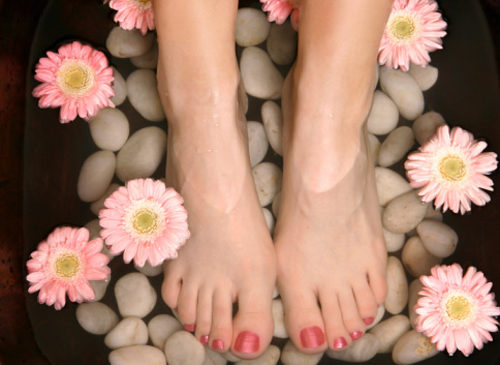It’s the middle of sandal season and finally feet are getting a break from the constraints of high heels and dirty sneakers. Some feet, though, are looking a little worse for the wear at this point. Thankfully, there are a number of natural ways to get your tootsies looking clean and beach-worthy.
One Step at a Time
A number of products and stages go into keeping feet clean and healthy. After a long day of working and being on one’s feet, there’s nothing more soothing than a relaxing footbath. Have customers start by soaking feet in a tub of water mixed with essential oils. There are a number of different oils to include in these, each bringing its own benefits.
Suggest including lavender in a footbath for its gentle and comforting qualities. Along with being relaxing, lavender has antibacterial, antiviral and anti-inflammatory properties, perfect for helping tired, sore feet. It also cuts down on a buildup of excess sebum, which skin bacteria feed on (1).
Peppermint oil is a very commonly included ingredient in foot care. It has been said to have antiseptic and anti-inflammatory properties, which make for a healing and soothing soak. A footbath with peppermint oil may also help increase circulation and have a cooling sensation that is wonderful for hot, tender feet (2).
Lemon is another ingredient to consider adding to a footbath. This citrus oil increases circulation and stimulates the feet, making for a refreshing bath (3).
The skin on your feet can easily become dry and cracked. To help consumers make their feet look smooth and fresh, guide them to some natural exfoliating products. Strawberries are often utilized in exfoliating scrubs. The natural juices and oils from the berries help to nourish feet as dead skin is removed. Almonds are also used in these scrubs for the same reason (4). Instruct customers to focus on tough, hardened skin when using these products to smooth away dry areas.
It is important to keep feet moisturized to avoid cracks in the skin. Lotions infused with coconut oil are especially good for deep moisturizing. While aiding the removal of dead skin cells, coconut oil helps strengthen underlying tissues. It also helps keep skin’s defenses stay strong against infections such as athlete’s foot (5).
It is even more essential for diabetics to keep their feet moisturized, to avoid problems such as foot ulcers. For customers suffering from diabetes, guide them to products that include ingredients that aid in cell regeneration and healing cracked skin, such as shea butter (6).
Kick Chemicals to the Curb
For your customers partial to pedicures, offer them a natural alternative to chemical-filled nail polishes. While there are no completely natural nail polishes on the market yet, there is a new trend appearing in water-based nail polishes, a less toxic way to brighten fingers and toes. There is a lower amount of toxic chemicals in the formulas of these polishes, which also leads to less of a smell.
Without the presence of harmful chemicals like formaldehyde, the polish does not have such a detrimental effect on the nails. The nails are not stripped of their natural oils, so they do not get so dried out after polish use. These water-based polishes do take a little longer to dry and bond to the nail, but are otherwise similar to regular nail polishes. There are also special removers that work with these polishes, as acetone-based removers do not (7).
A Perfect Fit
Once shoppers’ feet are smooth and polished, they will be thrilled to show them off. Consider offering vegan and natural sandals. There are numerous materials used to make organic flip-flops. Some are made from strips of recycled car tires and inner tubes, hemp, bamboo and even recycled carpet padding (8). These materials give eco-conscious consumers new options for footwear, and these sandals make for comfortable and cute ways to show off beautiful and healthy feet. WF
References
1. Aromatherapy for Health and Home, “Essential Oils for Beauty & Bath,” www.aromatherapy-news.com/For-Beauty-&-Bath.html.
2. Dermaxime, “Peppermint Oil As Used in Preparations to Treat Aching Feet,” www.dermaxime.com/peppermint.htm.
3. “Get Back on Your Feet: How to Use Essential Oils in Foot Care,” essential-oil.com/uses-of-essential-oils_get-back-on-your-feet-how-to-use-essential-oils-in-foot-care-2_587.html.
4. Natural Beauty Care Guide, “Cracked Heels,” www.naturalbeautycareguide.com/natural-foot-care/cracked-heels.html.
5. Coconut Oil and its Wonderful Health Benefits, “Virgin Coconut Oil and Your Skin,” www.coconut-connections.com/skin_care.htm.
6. “Diet Isn’t Enough,” www.mydiabeticfootcare.com
7. Honeybee Gardens, “WaterColors Non-Peel Off Polish,” www.honeybeegardens.com/natural-cosmetics/products/npwcne.html.
8. Simple Shoes, “Materials,” www.simpleshoes.com/info/materials.aspx?g=info.
Published in WholeFoods Magazine, July 2010 (Published online ahead of print, June 21, 2010)









